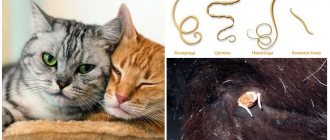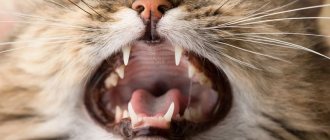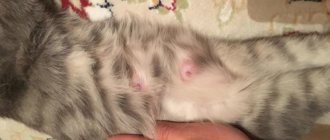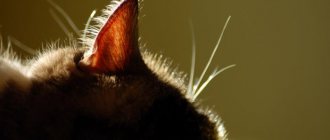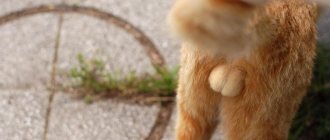If white feces are observed in a cat, this may indicate hepatitis of various etiologies, cholecystitis, cholelithiasis, infection with worms, and malignant neoplasms. The condition may be accompanied by jaundice, vomiting, fever, increased thirst and dangerous death of the animal. At the first symptoms, the owner should contact a veterinarian, who will diagnose the cat and prescribe treatment.
According to veterinarian statistics, 30% of diseases are liver pathologies, and the formation of stones in the bile ducts in cats is diagnosed 4 times more often than in cats.
Diagnostic methods
A thorough examination is required to make a diagnosis and prescribe therapy. First of all, the doctor must find out from the cat’s owners when and under what circumstances the changes began. The diet, previous diseases and features of the clinical picture are refined. After a general examination and temperature measurement, the following diagnostic methods are used in veterinary medicine:
- Analyzes. The cat's blood, urine and feces are taken for examination. The test results allow us to determine the general condition of the furry, the presence of parasites, liver and gallbladder diseases, and poisoning.
- Coagulogram. A study to determine the rate of blood clotting.
- Gastroscopy. Makes it possible to see the true condition of the inner walls of the stomach, detect ulcers or erosion, foreign bodies.
- Ultrasound of the peritoneum. Allows you to determine the presence of neoplasms and cysts, stones or sand in the gallbladder, and intestinal obstruction.
- Radiography. Detects liver enlargement and the presence of tumors.
- Biopsy. If a tumor is detected, the affected tissue is collected for analysis. Against the background of black feces and the accompanying clinic, the liver often suffers.
General examination Clinical examination Ultrasound of the peritoneum
Diarrhea symptoms
If the color of the bowel movements deviates from the norm, and your pet is losing a lot of hair, you should consult a specialist.
Cat feces that differ from the norm in color and consistency are already a pathological sign, indicating that not everything is in order with the pet’s body. Other symptoms that require immediate action:
- violation of general condition;
- nausea accompanied by vomiting;
- weakness, drowsiness, apathy;
- increased gas formation;
- persistent constipation or, conversely, diarrhea;
- increased body temperature;
- abdominal pain on palpation;
- blanching or yellowing of the mucous membrane;
- dullness and excessive hair loss;
- lack of appetite;
- rapid weight loss.
Regardless of the etiology (i.e. origin) of diarrhea, all its types can be divided into two large types:
- Acute diarrhea.
- Chronic diarrhea.
Accordingly, the symptoms of these two varieties will differ significantly.
In this case, everything is quite simple and clear. First, you need to decide on the terminology: “acute” diarrhea is called in cases where it began suddenly and lasts no more than two days, accompanied by a significant deterioration in the condition of the sick animal.
The following signs of such diarrhea are distinguished:
Defecation is frequent, the animal constantly runs to the tray.
As a rule, feces are liquid; they often contain impurities in the form of mucus, half-digested pieces of food, and sometimes blood can be seen.
After just five or six trips to the potty, the animal begins to meow hoarsely, constantly licking the anus area.
If diarrhea continues for more than two days, the cat becomes noticeably weaker. In the most severe cases, the pet practically stops grooming itself, its fur becomes matted and becomes covered with a crust of dried feces.
In the same cases, severe blanching of all visible mucous membranes is observed. They become dry and sticky to the touch. The skin loses its elasticity, the coat becomes rough and hard.
The following conclusions can be drawn from all of the above:
If diarrhea lasts less than a day, and the general condition of the animal at this time remains stable and does not cause alarm, you can try to cope with diarrhea on your own.
In cases where a cat suffers from diarrhea for more than a day, and its condition is slowly but deteriorating, you should definitely show the animal to a veterinarian
This precaution will probably not be superfluous.
This type of pathology manifests itself somewhat differently:
Diarrhea occurs sporadically, not every day.
Interestingly, cases of diarrhea may well alternate with periods of “impenetrable” constipation.
The cat’s condition “by eye” remains normal, but this impression is wrong. If nothing is done and the true root cause is not identified, the animal will gradually develop exhaustion.
White feces in a cat: causes of color change, treatment and prevention
White feces in a cat is a sign of improper functioning of the pancreas, liver or gallbladder. A responsible and attentive owner will never ignore a pathological change in the color of feces in an animal
It is important to identify the cause of light-colored stool in time and begin treatment if the disease is present.
Stool color and consistency in a healthy animal
The appearance of feces allows you to assess the health of a cat, cat or kitten. Normally, feces should be:
- dark brown;
- well formed (into a sausage);
- dense;
- wet.
Feces have a specific, mild odor. If the stool smells strongly, this also indicates problems with digestion.
In animals that eat primarily meat, the color of their stool is deep brown. When your pet's diet is dominated by dairy products, the feces will turn light brown or yellow.
If a cat, cat or kitten has white stool, this indicates the development of the disease. The owner needs to observe the animal for several days. If the stool continues to be an unnatural color, you need to reconsider your pet's diet or consult a veterinarian.
Causes of changes in stool color
White or light-colored cat feces warns of the possible presence of a dangerous pathology in the animal’s body. At the same time, the frequency and nature of bowel movements may change.
In the small intestine, feces are colored brown by bile. If the secretion of this physiological fluid is impaired, then the stool is light in color.
Veterinarians identify the following causes of white stool in cats:
- Cholelithiasis. It is a consequence of feeding your pet low-quality, cheap food. Along with it, urolithiasis is often detected. The bile ducts become clogged with sand and stones. Bile continues to be produced, but cannot leave the gallbladder. This can lead not only to digestive disorders, but also to organ rupture.
- Neoplasms in the liver, gall bladder and ducts. Cysts, benign or malignant tumors often cause disruption of the outflow of bile.
- Cirrhosis. Liver cells begin to degenerate. The pathological process is irreversible. With the help of timely therapy, you can prolong and make your pet’s life easier.
- Atony of the gallbladder. The walls of the organ are weak, stretched and soft. They do not contract and do not push bile into the ducts. This may result in organ rupture.
- Deformation of the ducts. The pathology can be congenital and affect the appearance of stool.
- Inflammatory processes in the liver. Most often they are observed with hepatitis and cholangitis.
If the animal has white feces only once, the reason may be due to diet. This happens when there is an excess of phosphorus in the body. Light-colored feces are normal after a pet has eaten a lot of fish (especially river fish). However, the owner must understand that this type of diet is unacceptable for an obligate predator.
Treatment and prevention
The therapeutic course depends on the cause of the change in the color of feces. If an alarming symptom is detected, it is necessary to show the animal to a doctor. To make a diagnosis, the veterinarian will comprehensively examine the cat.
Diagnostics includes:
- external examination of the pet;
- taking blood, stool and urine tests;
- performing an ultrasound, MRI or CT scan of the abdominal organs;
- radiography;
- biopsy of pathologically changed tissues.
The doctor decides what to do and how to treat the animal.
If there are neoplasms, stones in the gall bladder or rupture of an organ, the animal undergoes urgent surgery. If sand is present, a therapeutic diet and diuretics are prescribed.
To eliminate inflammation, the veterinarian prescribes antibiotics, antiviral and anti-inflammatory drugs, as well as immunomodulators for the pet.
It is important that the animal consumes plenty of fluids throughout treatment.
The owner’s task is to ensure proper maintenance and care.
Particular attention should be paid to nutrition. The diet is prescribed by the doctor
The diet should consist of medicinal feed or natural products (fresh meat, liver, stomachs, lungs, vegetables, a small amount of cereals). The pet should not be fed human food (fried meat, sausages, fish, soup, borscht, etc.).
Treatment and prevention of pathologies of the liver, pancreas and gall bladder are closely related. To avoid relapses, your pet must be regularly brought for veterinary examination, given all vaccinations and provided with a balanced diet (high-quality industrial feed or natural products).
Eating disorders
Owners try to feed purebred cats and cats correctly, in a balanced manner, choosing special food or a diet made from natural products. And this approach is competent and allows you to maintain the beautiful appearance of the animal and its good health.
But sometimes there is a desire to give your pet an extra portion or feed him something fried or delicious pastries. The digestive system, not ready for such changes, malfunctions, food cannot be digested normally, and as a result, diarrhea begins.
Loose stools can also be caused by food that seems safe for cats, such as milk or raw river fish. The causes of diarrhea are varied, but most often veterinarians have to deal with overeating of a pet, which was facilitated by the owner’s desire to pamper the pet.
Food is poorly digested, putrefactive processes occur on the mucous membranes of the intestines, which is why the epithelium comes off, from which mucus is obtained.
Diarrhea can also be caused by a sudden change in the brand of food.
Both manufacturers of ready-made food and veterinarians recommend gradually introducing a new type of food, stretching the transition process over several days.
Treatment and prevention of worms
Treatment and prevention of helminthic diseases are carried out with the same drugs, or rather, active ingredients
The only difference is that when treating long-term helminthic infestations, additional precautions or therapy may be required. The composition of all drugs for worms is similar and usually includes two active ingredients
Substances that eliminate roundworms:
- Piperazine.
- Pirantel.
- Milbemycin.
- Fenbendazole.
Substances that eliminate tapeworms:
Praziquantel and analogues.
The dosage form in the form of drops may have a complex property - eliminate external and internal parasites. In this case, the drug will contain a third active ingredient:
- Fipronil.
- Ivermectin.
Important! Strictly follow the dosage of the drug and carefully read the instructions before use. Poisoning with prophylactic drugs provokes additional intoxication, which has a very detrimental effect on the functioning of the heart, kidneys and liver
If drugs are used for prophylaxis, the application algorithm is as follows:
Tablets and suspension - given in the morning on an empty stomach, on the root of the tongue. If you cannot give your cat the medicine, it can be mixed with a small amount of food. The tablets are pre-crushed into powder.
Drops are applied to the withers or back of the head at any time convenient for you. Until the drops are completely absorbed (usually 2-4 hours), you need to monitor your pet so that he does not lick the drug or use an Elizabethan collar.
Critical helminthic infestations require additional precautions. Before starting treatment, be sure to consult your veterinarian
Most likely, the animal will be prescribed shock and maintenance therapy to prepare the body for the load.
If there is a threat of intestinal blockage or perforation, an incomplete dose of the drug is used, after which the cat is given an adsorbent and a laxative. Such measures lead to only partial death of the parasites, so the drug is repeated after 5–14 days.
What to do for prevention?
Preventive measures involve systematic treatment for worms.
Liquid or dry feces that are constantly observed in a pet are, in any case, evidence of some kind of internal progressive disorder
To prevent consequences dangerous to the cat’s health and life, it is important to follow preventive rules. First of all, it is important to monitor the cat’s diet and provide it with fresh and clean water.
Do not forget to carry out preventive anthelmintic treatment.
If viral infectious diseases develop, do not self-medicate, but take the animal to a veterinarian, who, based on the diagnostic results, will select an effective treatment. In order for the cat’s body to more actively resist various diseases, it is useful to strengthen the pet’s immunity. To do this, it is recommended to give courses of vitamins and various biologically active supplements, which are selected by the veterinarian, taking into account the individual characteristics of the cat.
Is a cat whose stool has become light-colored contagious?
How dangerous is it to be around a cat whose stool has changed color? An animal may be contagious if problems with the digestive system are caused by a viral, bacterial infection or parasite.
Toxoplasmosis, caused by the parasitic protist Toxoplasma, is one of the causes of inflammation of the gallbladder and ducts. For healthy people with good immunity, Toxoplasma poses virtually no threat. The situation is different for pregnant women or women who become infected on the eve of conception. Parasites can affect the development of the fetus, cause irreversible changes in the development of its internal organs, and provoke miscarriage or stillbirth. In antenatal clinics, pregnant women are required to undergo testing to detect toxoplasmosis.
Changes in the color of stool may be a consequence of infection with worms, which not only settled in the intestines, but also spread throughout the body, including ending up in the liver
Worms are quickly transmitted from cats to humans, so you need to avoid contact with a sick animal, take special care when cleaning the toilet, and keep children away from it
What are pinworms in children?
Infection with worms is often caused by eating unwashed fruits.
Enterobiasis is a disease caused by the appearance of pinworms in the small and large intestines of the body. Pinworms are also called worms. These parasites look like small white worms. They are small in size: females up to 1.5 cm, and males up to 5 mm. Their color is always white. The habitat in the human body is the intestines, but there are exceptions when they live in other organs. The female parasite reproduces quite quickly. Every day at night, she can lay eggs near the anus or in the folds of the skin. The affected areas may be the perineum.
During the process of the emergence of worm embryos, the child experiences severe itching as the infected area of the skin becomes vulnerable. Nematodes mature quite quickly and penetrate the intestine and attach themselves to the intestinal walls. After the female has laid eggs, she dies. Girls have a hard time coping with this disease. Worms, crawling out, can penetrate the mucous membrane of the external genitalia, causing additional infections. This does not mean that the disease does not need to be treated. During a short lifespan, a female can lay many eggs. The disease is gaining new momentum and the baby’s condition is worsening.
If no treatment is given, the parasite dies after 50 days.
What treatment is prescribed?
If stool that is too liquid or too hard is a consequence of poor nutrition, the first thing you should do is review your pet’s diet. When feeding natural food, it is recommended to diversify the menu with steamed vegetables and fruits, teach the cat to eat special cat grass, which not only normalizes digestion, but also saturates the body with vitamins and essential elements
If your pet is accustomed to dry food, it is important to ensure that clean and fresh water is freely available.
For constipation, medications with a laxative effect are prescribed, for example:
The feces will become soft if you give the animal Vaseline oil. For hepatitis, a course of antibiotics and hepatoprotectors is prescribed. If there is a dysfunction of the gastrointestinal tract, antacids, probiotics, and medications that improve peristalsis are used.
If there is excessive internal bleeding, the veterinarian will recommend surgery. The procedure is carried out under general anesthesia, after the operation there will be a rehabilitation period, during which the cat will be prescribed a special diet, a course of drug therapy and other restorative procedures
At this time, it is important to monitor the nature of your pet's stool. It should be moderately soft, without foreign inclusions or unpleasant odor.
It is important for the owner to remember that the earlier the disease is diagnosed and treatment prescribed, the better the chances of a full recovery.
What should a cat owner do first?
White feces in a cat - what to do? Doing anything on your own in terms of medication intervention is highly not recommended. You only need:
- over the past few days, analyze what and how Murka was fed;
- adjust feeding if nutritional disturbances are detected;
- monitor over the next few days whether there is a change in the color of the stool towards darkening;
- if a change in feeding does not lead to the restoration of the color of the stool, you should visit a veterinarian, preparing as detailed an anamnesis as possible (information about the keeping and feeding of the animal, prior to the lightening of the stool);
- If white worms are found in a cat’s feces, the feces should be submitted for parasitic analysis.
Diagnostics
The reason for the lightening of excrement can be determined during an ultrasound of the animal’s hepatobiliary system.
To find out why a cat has light-colored stool, the veterinarian conducts an external examination of the animal and prescribes diagnostic methods, such as:
- scintigraphy;
- radiography;
- Ultrasound of the liver and biliary tract;
- general and biochemical blood test;
- fecal analysis for helminth eggs;
- biopsy.
Reasons for changes in stool
Changes in the color and consistency of feces in a kitten or adult cat are often associated with errors in nutrition. When eating unsuitable food, the load on the digestive organs increases. The stomach does not completely digest food, and the intestines cannot fully absorb it. The result is unformed feces in which mucous particles can be found.
Other common causes
But in addition to poor-quality food, the following diseases and disorders can affect the consistency of excrement:
- Intestinal dysfunction. Insufficient secretion of digestive juices and weak peristalsis contribute to stagnation and fermentation of eaten food in the body. Soon, pathogenic microflora begins to actively multiply, causing increased gas formation and flatulence. The cat's feces turn out to be green.
- Insufficient enzymatic activity of the pancreas. The consequence of this disorder is poor digestion of food, resulting in yellow feces remaining in the tray.
- Hepatitis. As the disease progresses, the functioning of not only the liver, but also the gallbladder is disrupted. As a result, the cat's feces become discolored, but the urine becomes dark brown.
- Internal hemorrhage. If the cat passed liquid black feces onto the tray, this means that bleeding has occurred in the stomach, or more precisely, in the upper section. When bright red blood is present in the stool, this indicates that damage has occurred in the intestine itself.
Orange dry feces often appear in pets when they eat food colored with dyes. If the stool is not soft, but hard, like a goat's, this means that the animal's diet does not have enough fluid. In this case, it is enough to adjust the menu and change the brand of food. If, even after changing the diet, the cat poops liquid or too dry, it is better not to hesitate to visit the veterinarian.
Pinworms - Baby food
“Sadikov's disease” - enterobiasis?
When a child’s body is affected by worms, the mother must take care of the baby’s specific nutrition. Eating the right foods can speed up the healing process. It is worth including in the diet:
- Spicy dishes. Pepper and spicy dressings worsen the habitat for pinworms.
- Sour vegetables and fruits. In an acidic sphere, parasites die faster.
- Horseradish with mustard. Not all kids will like such a specific product. But it undermines active reproduction and temporarily paralyzes the worms.
- Walnuts, flax seeds, pumpkin seeds. Such products help destroy parasites in the intestines.
- Olive and vegetable oil. Relieves irritation of the intestinal walls.
- Dairy products. With their use, medications are better absorbed and the intestinal microflora is not disturbed.
During the period of illness, it is recommended to exclude sweets, fatty foods, and foods with a chemical composition - the consumption of harmful foods creates all the conditions for the further proliferation of pinworms in the child’s body.
Diagnosis and treatment of black feces in cats
Of course, black stool itself cannot be cured, since it is only a symptom of a disease. Therefore, in order to understand what therapeutic measures are appropriate to apply in a particular case, it is necessary to conduct a diagnosis. Here are the diagnostic measures we are talking about.
1. So, first of all, it is imperative to analyze the stool for the presence of hidden traces of blood in order to find out whether there really was bleeding, or whether your cat’s stool is black and liquid because he ate cherries and is now suffering from illness belly.
Before prescribing treatment for your cat, you must be examined by a veterinarian.
2. If blood is detected in the feces, the cat will have to be tortured a little more with diagnostic measures, such as:
- ultrasound examination of the abdominal cavity;
- radiography;
- gastroscopy.
Gastroscopy for a cat
3. Provided that blood has been detected in the stool, it is also recommended to take biological fluids for analysis. Thus, the following studies are most often carried out:
- blood for clotting (coagulogram);
- general blood analysis;
- blood chemistry.
Provided that at a particular stage the veterinarian decides that the time has come to make a diagnosis, because he has accumulated enough information for this, then further research will be carried out only at the insistence of the owner. However, even if you are the most caring and meticulous owner on earth, as a rule, subsequent studies only confirm the doctor’s earlier conclusions.
Various medications will effectively help with a particular ailment.
Provided that the doctor has decided on the diagnosis, depending on what pathology was discovered, a variety of medications may be prescribed. Let's see which ones in the table below.
Table 4. Medicines prescribed to cats for treatment of black stool
| Area of application of the drug | Description |
| Hemostatic drugs | So, first of all, drugs that are responsible for stopping the blood are prescribed. The fact is that loss of blood in any case aggravates the disease, therefore, in order to seriously improve the animal’s condition and give it a chance to recover, it is necessary to use a remedy to eliminate bleeding. Here are the medications veterinarians usually prescribe today. 1. The drug "Tranexam". 2. The drug "Vikasol". 3. The drug "Ditsinon". |
| Antiparasitic drugs | In the case when the cause of all your cat’s ailments are parasites, and it is their negative effect on the walls of the gastrointestinal tract that leads to bleeding and, as a result, darkening of the stool, it is necessary to give the cat antiparasitic drugs, for example: “Dirofen”; "Dironet"; "Prasitel"; "Milbemax"; "Drontal"; "Piratel." |
| Antibiotics | To treat diseases such as peptic ulcers, gastritis, colitis, etc., it is necessary to take antibiotics - drugs that inhibit the growth of living cells. The best medications for dealing with ailments affecting the gastrointestinal tract are: Amoxicillin; "Amoxiclav"; "Penicillin"; "Tetracycline"; "Gentamicin", etc. All of the listed medications are products originally developed for human use, so you can buy them directly in human pharmacies. The dosage in this case must be determined by the attending physician. |
| Antiviral drugs | Provided that the disease affecting the gastrointestinal tract of your animal was caused by some kind of virus, it is necessary to take remedies that directly destroy this virus, otherwise all other treatment will not make sense. So, for cats, drugs such as: “Cycloferon” are suitable; "Gamavit"; "Interferon". |
| Gastroprotectors | To protect your beloved pet's gastrointestinal tract from the negative effects of all medications taken, as well as from toxic secretions associated with the disease, it is necessary to use drugs called gastroprotectors - protectors of the digestive tract. Such drugs will include: “Almagel”; "Phosphalugel"; "Maalox"; etc. Believe me, these products will have an extremely positive effect on the state of your pet’s digestive system. |
The veterinarian has the right to independently determine the list of drugs suitable for the treatment of a particular ailment in cats
You have no right to independently determine the medications your cat needs, as this will most likely only worsen the situation.
Normal defecation process
Causes of bloody stool in cats
The presence of blood at the end of stool indicates a developing pathology in the animal’s body.
There are several reasons for this phenomenon:
- anal injury;
- rectal injury();
- intestinal diseases;
- inflammation of the paraanal glands;
- giardiasis;
- isosporosis;
- dipylidiasis;
Most of the listed diseases are manifested by blood in the feces already when they are firmly entrenched in the body of a sick cat, which means that urgent measures need to be taken.
Trauma to the anus and damage to the rectum are expected. Release of previously swallowed foreign objects with sharp edges, wood chips.
Reasons why stool becomes lighter
Hepatitis of various etiologies
Normally, the color of a cat's stool is brown, formed, and moderately dense. When the liver and biliary tract become inflamed, the flow of bile is disrupted, which is why the cat has white feces. Hepatitis is non-infectious when an animal comes into contact with pesticides for a long time or accidentally ingests poisonous plants. Infectious inflammation is caused by bacteria and viruses. Symptoms:
- temperature increase;
- darkening of urine;
- yellowness of the mucous membranes and eye sclera;
- increased thirst;
- diarrhea or constipation (stool is excreted in round, dense grains);
- weight loss;
- heart rhythm disturbance.
Cholecystitis
With this non-arc, the animal does not feel the desire to play with anything.
With this disease, the gallbladder becomes inflamed, which leads to stagnation and decreased flow of bile. The cause of the disease is poor-quality or expired food, abdominal injuries, irregular nutrition, metabolic disorders, severe infectious diseases, and worms. In addition to the fact that the cat’s stool becomes gray or whitish, the following signs are observed:
- jaundice;
- frequent vomiting;
- loss of appetite;
- lethargy, refusal to play;
- dry mucous membranes;
- increased need for water;
- dull, patchy fur.
Cholelithiasis
Cholelithiasis is characterized by the formation of stones in the intrahepatic and biliary tracts and bladder that block the ducts. Most often it develops against the background of liver pathologies, as well as due to metabolic disorders of cholesterol, phospholipids, bilirubin, bile acids and pigments. This promotes the formation of thick bile and cholesterol crystals in it, which later become denser, forming stones. Symptoms:
The presence of stones in the gall bladder causes the pet to lose a lot of weight.
- jaundice;
- vomit;
- dehydration;
- decreased heart rate;
- abdominal pain;
- weight loss;
- white stool;
- skin itching.
Worm infestation
If a cat poops white feces, it may be liver damage from helminths such as fluke, roundworm, toxocara, cucumber tapeworm, hookworm. Worms and their eggs clog the bile ducts, disrupting the flow of bile. Parasites enter a cat's body by eating raw fish or meat, grass, drinking contaminated water, or licking its paws after a walk. Manifestation:
- stool is white or gray;
- vomit;
- itching in the anus, the cat “rides” on its butt;
- hair loss;
- skin rashes and redness;
- deterioration of wool structure;
- liver enlargement;
- yellowness of the sclera and mucous membranes;
- abdominal pain;
- refusal of food;
- stool instability.
Cancer tumor
With such a serious illness, the animal often goes to drink water.
A cat is diagnosed with sarcoma or carcinoma, which metastasizes and has a rapid progression. The formation of a tumor in the liver and bile ducts is most often secondary, occurring against the background of a lesion in the body. In addition to the light shade, there is a bloody admixture in the stool. In the initial stages, the disease is asymptomatic, then the following symptoms appear:
- vomit;
- increased thirst;
- sudden weight loss;
- anemia due to internal bleeding;
- diarrhea;
- yellowness of mucous membranes;
- lethargy, lack of vigor;
- frequent urge to urinate.
Causes of light-colored feces in babies
If a kitten has white stool, this may indicate a lack of enzymes secreted by the pancreas. Yellow feces occur if only milk is present in the baby’s diet. In older kittens, a deviation in color may indicate dyspepsia and fermentation processes in the gastrointestinal tract.
Ways of infection by pinworms
It is easy for a child to become infected with such a disease. He leads an active lifestyle, learning new things and playing with other children and animals. A baby can “catch” parasites in several ways:
- Oral. The child scratches the anus and parasite eggs get under the nails. Anything that the baby touches with his hands can be a site of infection.
- Bytovym. After contact with dirty toys, after eating dirty vegetables. This method is the most common. Pinworm larvae remain on the hands and, once they enter the oral cavity, they easily reach a favorable habitat.
- Contact. Favorite pets are the main breeding grounds for worms. Children love to play with them and often do not wash their hands after contact.
The most common cause is failure to maintain normal hygiene. Dirty hands, stale linen, close contact with mucous membranes have a beneficial effect on the appearance of enterobiasis. By teaching your child to be clean, you can protect him from many infections and helminth infections.
What to do for prevention?
Liquid or dry feces that are constantly observed in a pet are, in any case, evidence of some kind of internal progressive disorder
To prevent consequences dangerous to the cat’s health and life, it is important to follow preventive rules. First of all, it is important to monitor the cat’s diet and provide it with fresh and clean water.
Do not forget to carry out preventive anthelmintic treatment.
If viral infectious diseases develop, do not self-medicate, but take the animal to a veterinarian, who, based on the diagnostic results, will select an effective treatment. In order for the cat’s body to more actively resist various diseases, it is useful to strengthen the pet’s immunity. To do this, it is recommended to give courses of vitamins and various biologically active supplements, which are selected by the veterinarian, taking into account the individual characteristics of the cat.
Why is my cat's stool white: urgently go to the clinic
The coloring of feces in a light color does not always indicate errors in nutrition. There are situations when the breeder must deliver the cat to the RosVet Exhibition Center immediately. The list includes:
- liver pathologies occurring with metabolic disorders and inflammation (hepatitis, hepatosis);
- the pancreas does not provide enough enzymes for digestion;
- developmental anomalies of the gallbladder and its ducts (adhesions, torsion);
- cysts, purulent abscesses;
- cirrhosis of the liver (with pathology, little bile is produced);
- cholangiohepatitis, cholangitis (inflammatory process in the bile ducts and bladder).
You should be alert to some kidney diseases, in which there is an accumulation of toxic products in the body, which then affect the functioning of the liver. Tumors of various origins in the liver and biliary system can interfere with the normal release of bile into the intestines. The absence of bladder contractions (atony) completely stops the flow of bile into the gastrointestinal tract, and there is a risk of rupture and peritonitis.
What might the stool of a sick animal look like?
In the tray of his pet, the owner may find feces that differ in shape:
- ointment-like;
- mushy;
- liquid;
- foamy;
- in the form of “goat peas”;
- in the form of a tape or pencil.
By smell they distinguish: sour, rancid, putrefactive.
- Feces acquire a sour smell when the absorption of fatty acids in the small intestine is disrupted or due to fermentation processes in the large intestine.
- An unpleasant odor, similar to the smell of bad oil, occurs when the secretory function of the pancreas is disrupted or when the flow of bile is disrupted.
- The smell of rotting occurs when digestion in the stomach is disrupted, dyspepsia develops with the proliferation of putrefactive microflora in the intestines. Or the cat suffers from colitis with ulcerations.
It is customary to distinguish feces by color:
- red (beetroot);
- black (tarry);
- dark brown;
- light brown;
- with a scarlet admixture (undigested blood);
- yellow;
- light yellow;
- greenish yellow;
- bleached slightly yellow, gray, gray-white.
A healthy cat can have red or beetroot feces if it has eaten beets or food colored with bright dyes. This coloring is not pathological and soon the stool acquires a normal color.
About the structure and appearance of feces
Yes, this may not seem very pleasant, but for the sake of the health and, possibly, the life of your cat, it is necessary to carefully evaluate the appearance, structure, consistency and other characteristics of the feces excreted by the animal.
The norm for cats is brown color and pasty consistency of feces. Again, normally during bowel movements they should be released in one portion. Wateriness and “goat balls” immediately indicate some kind of pathology. By the way, “balls” directly indicate a lack of water in the pet’s diet. This often happens to animals whose owners keep them exclusively on dry food. The yellow color of these pellets may be due to the characteristics of a particular food. It is urgent to show the animal to a veterinarian in the following cases:
- Greenish-yellow or yellowish-white stool with a cheesy consistency. Such symptoms indicate that food in the cat’s gastrointestinal tract is practically not digested.
- Watery, yellow and runny. It is very possible that your pet has a serious eating disorder or even an infection.
- The same yellow feces, but with mucus (especially cloudy), from which an unbearable smell emanates - a clear indication of some kind of infectious disease of the gastrointestinal tract or a massive helminthic infestation.
- Regardless of the color of the stool, the presence of blood in it is an extremely serious sign. There are many reasons for the appearance of blood in stool. They have one thing in common - a potential danger to the health and life of the pet. If there is blood in the feces, call a veterinarian immediately.
The main reason for the appearance of yellow stool is the acceleration of intestinal motility. The fact is that in the duodenum, bile is “injected” into semi-digested food masses. If digestion proceeds normally, bilirubin contained in bile gradually turns into stercobilin. It is this that, by the way, gives feces its characteristic brown color. In cases where the passage of food through the gastrointestinal tract is sharply accelerated (during infections, poisoning, due to worms, etc.), only bilirubin, which has a bright yellow color, reaches its “destination”.
